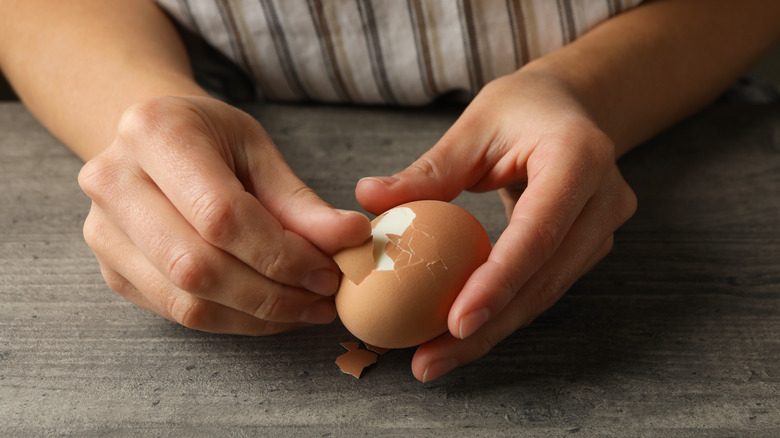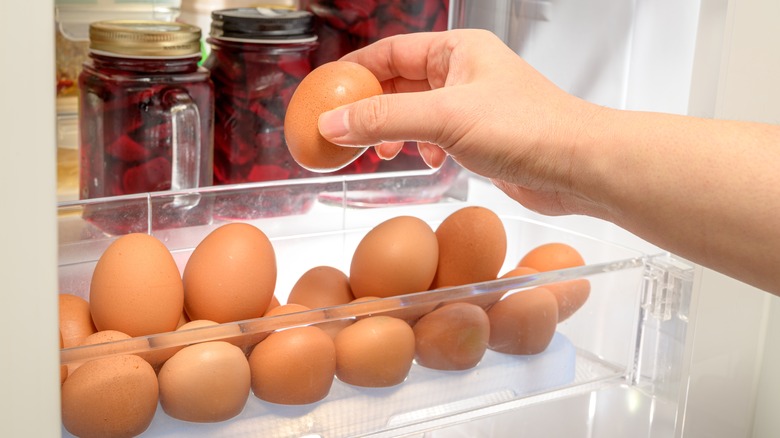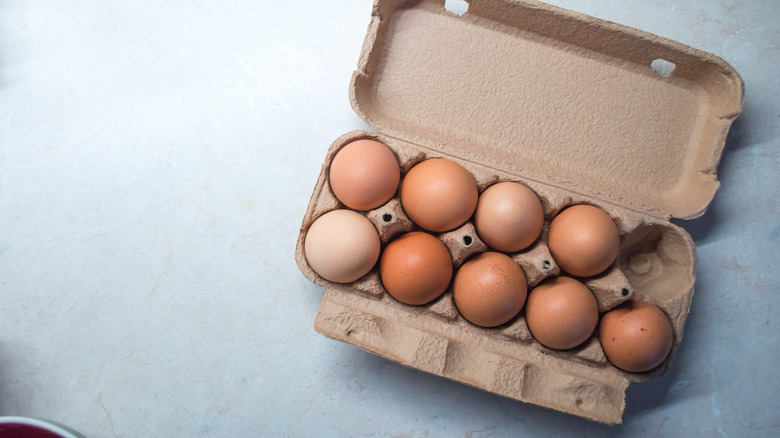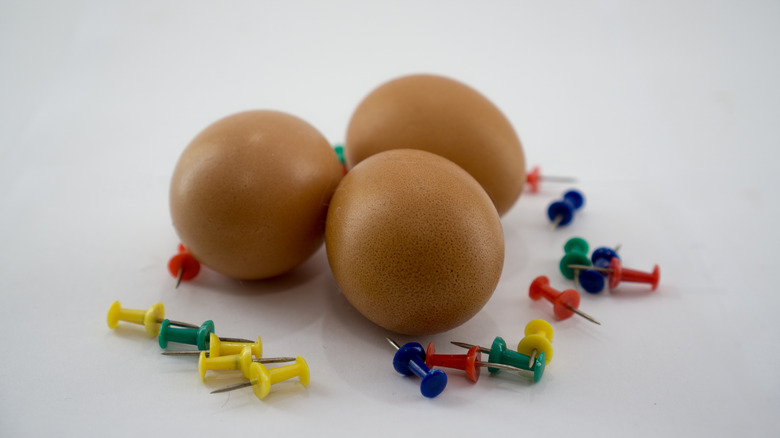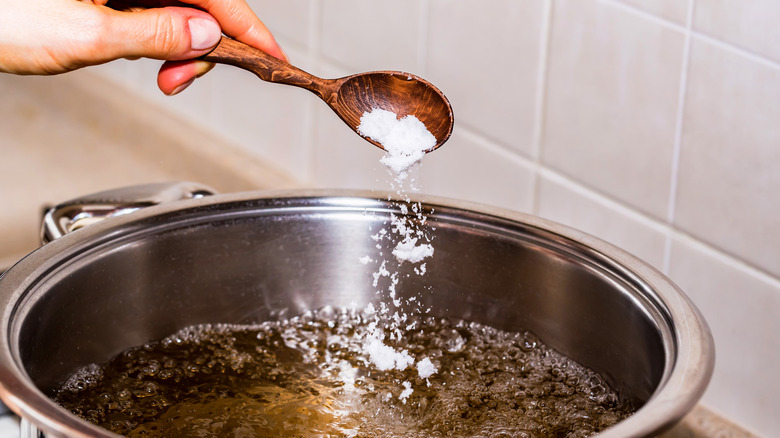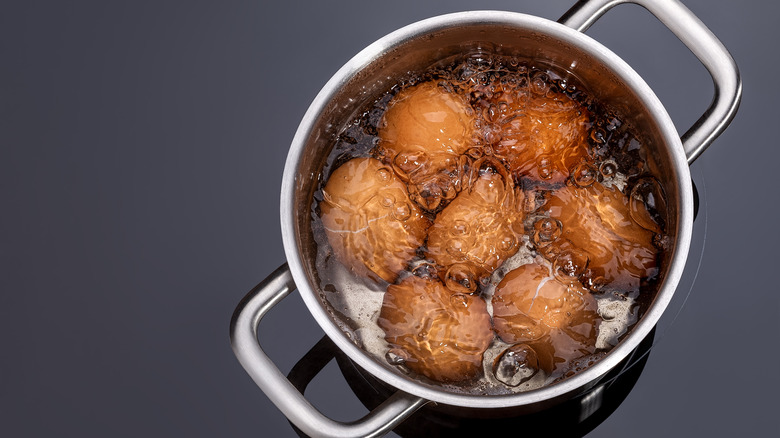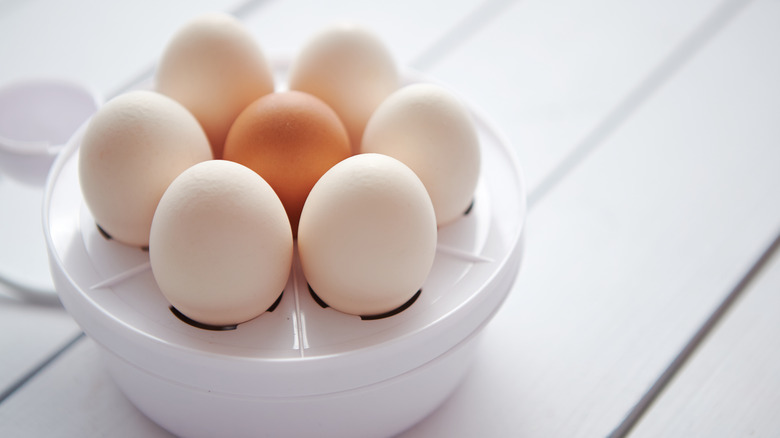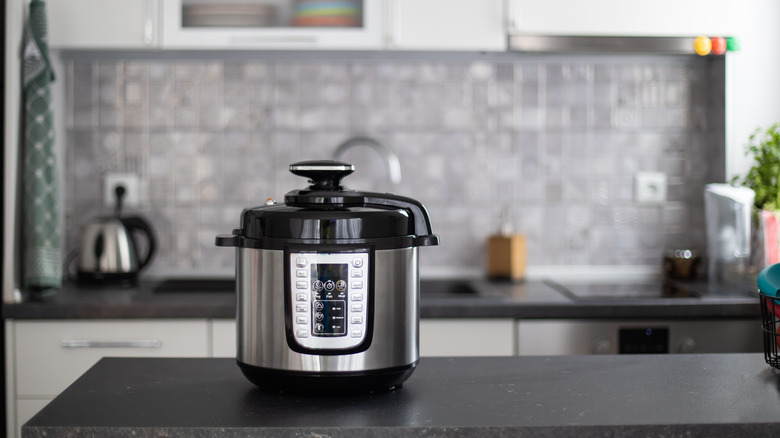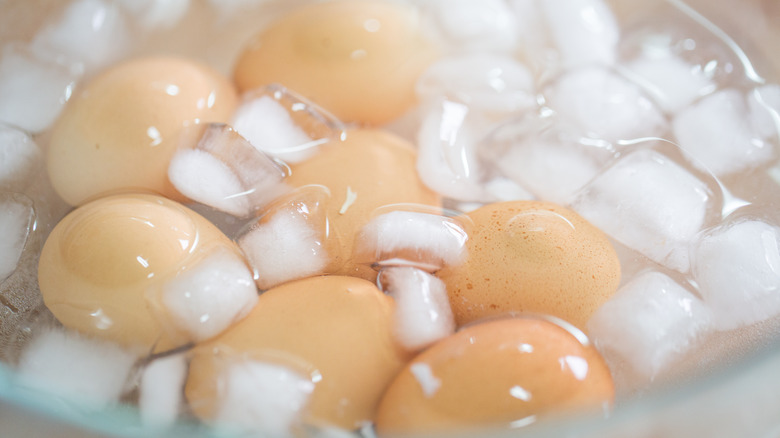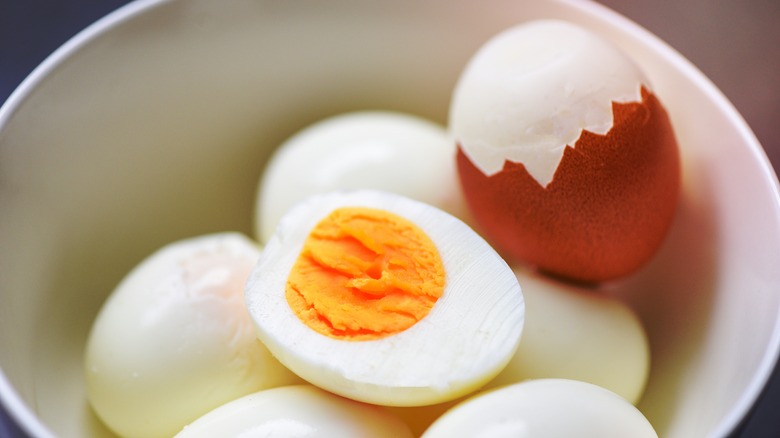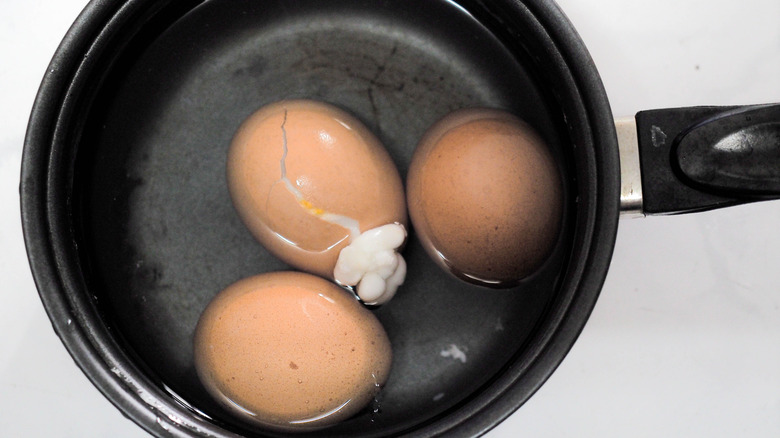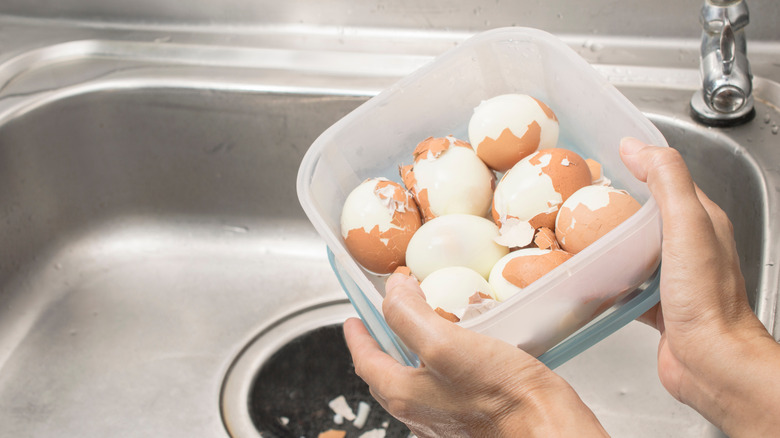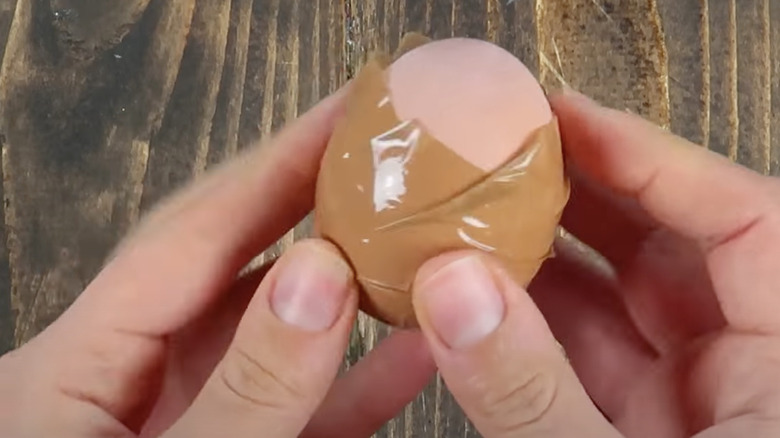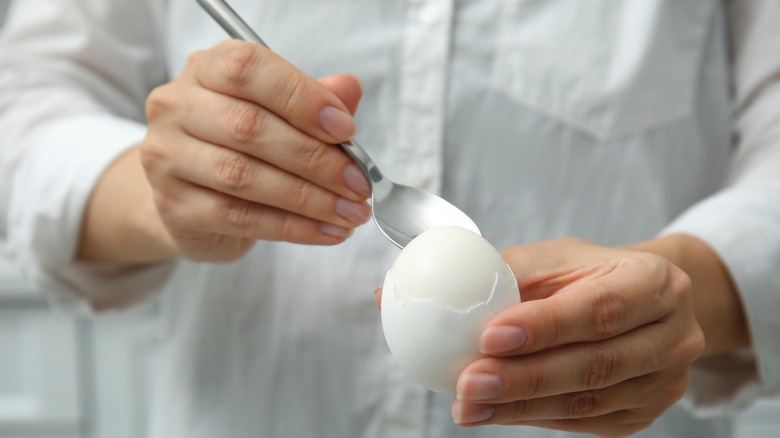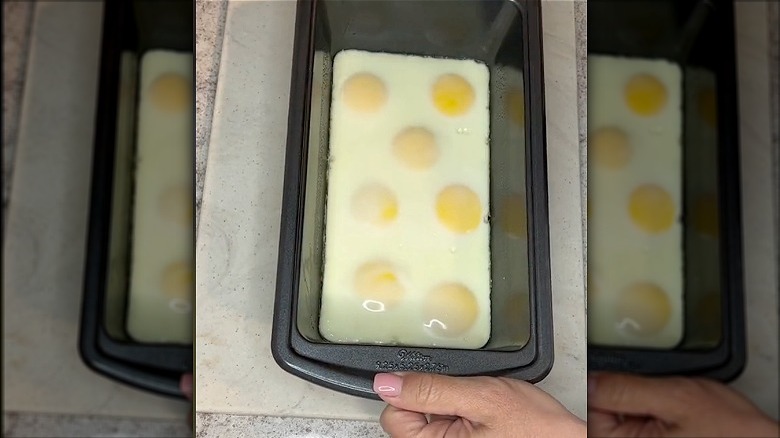15 Tips For Peeling Hard-Boiled Eggs
One of our least favorite tasks in the kitchen is peeling hard-boiled eggs. It's hard enough to produce a flawless boiled egg — you know, one with perfectly set yolks and without the dreaded green-tinge or overly sulfuric aroma. It adds insult to injury when the egg sticks to the shells, and you end up peeling off half of those precious whites along with them. If you're going through to the process of boiling eggs, you want to make those out of that experience. Thankfully, there are a few things you can do to keep your eggs intact and prevent that undesirable, aesthetically unappealing pockmarked exterior.
These tips for peeling hard-boiled eggs involve a few things you can do before the egg even goes into the water and several tricks that make life so much easier after the egg is cooked. Feel free to combine a few egg-peeling hacks to ensure your egg whites turn out smooth and presentation-ready.
Use old eggs
The easiest way to make hard-boiled eggs easier to peel starts with the age of the egg itself. The reason some eggs are harder to peel than others has a lot to do with how the egg white's protein bonds to the shell's membrane. When that bond is strong, the egg sticks to the shell and flakes off as you peel.
The secret here is to use older eggs. As eggs age, their pH level increases, discouraging the egg proteins from clinging to the shell. Science stuff aside, that means that old eggs are just naturally easier to peel without any other hacks or tricks. If you're a planner, pick up a second carton of eggs and let it sit in the back of the refrigerator for a week or two prior to your hard-boiled egg date. Before you worry about the sell-by date on the carton, the U.S. Department of Agriculture (USDA) notes that eggs are good for three to five weeks from the date they're placed in the refrigerator — even if the sell-by or expiration date expires. You should be fine as long as you purchased them before that date.
Start with room temperature eggs
Regardless of whether your eggs are new or old, you would be making a mistake if you boil eggs straight from the fridge. Instead, try starting with room-temperature eggs. The idea here is that the temperature difference between the cold, refrigerated eggs and the hot, boiling water will cause the whites to cling to the outer casing, resulting in an egg that's more difficult to peel.
When you know you're making hard-boiled eggs, pull the eggs out of the fridge about two hours before you boil them. We don't recommend leaving them out longer than that, though, as the USDA advises that's the maximum amount of time before bacteria in or on an egg will begin to grow. Even if you didn't think to plan ahead, even letting the egg sit on the counter for five while you wait for your water to boil can make a difference in how easy they are to peel.
Prick the eggs with a thumbtack
Another popular hack involves pricking the egg with a thumbtack before you cook it. It's important to start with a clean thumbtack here so you don't introduce any bacteria into the egg, so please don't pull one out of the wall and use it without washing it first. We were introduced to this technique as Jacques Pepin's secret to perfect eggs, and it's the one we've been using in our home kitchens for years.
To make it happen, identify the rounder, larger end of the egg and prick it with the thumbtack. This side will be slightly flatter and wider than the more oval-shaped and pointy top end, and it contains a small air pocket. The pinpoint won't be long enough to release the egg whites from inside the shell, but it will release air and gasses. You'll notice a ton of tiny air bubbles escaping from the hole when you drop it into water. That means the pressure inside the egg is also being released, and water can get in between the egg membrane and the shell, making it easier to peel later.
Add baking soda or vinegar to the boiling water
If you don't have time to wait for your eggs to age, there are a few hacks that will make boiling your eggs so much easier. These involve adding an ingredient to the boiling water, each of which can help to ease the eggs out of their shells after they're cooked. If you don't mind a slightly sulfury aroma to your boiled eggs, add half a teaspoon of baking soda to every quart of water in the pot. Baking soda is alkaline, and reducing the pH of the water will help prevent that bond between egg protein and shell membrane.
Alternatively, you can add vinegar to the water. This might seem counterintuitive since vinegar's acidity would raise the pH of the water. However, eggshells are made up of calcium carbonate, which can be dissolved by vinegar's acetic acid. Adding three tablespoons of vinegar per quart of water will help break down the shell so it's easier to peel later.
Cook the eggs in already boiling water
Many of us were taught to place eggs in a pot, fill it with water, and bring the mixture to a boil. As it turns out, that's not the only method, and peeling eggs got so much easier when we started cooking them in water that was already boiling. This trick works whether you're using old eggs or new eggs, and it applies to water with added baking soda or vinegar. Basically, starting eggs in cold water facilitates a slower cooking process, allowing the egg whites to bond to the shell membrane. If the water is boiling, the heat sets the exterior whites first before cooking the inside, resulting in less sticking during the peeling process.
The real trick here is protecting your hands from any hot water that might splatter as you lower the eggs into the water. We recommend using a tool like a spider strainer or a steamer basket insert, but you could also use a regular soup spoon. It's also important to measure your water beforehand to ensure that adding all those eggs won't cause it to overflow the pot.
Steam instead of boil
If you have a steamer basket, you might try steaming your eggs instead of boiling them. Basically, water releases steam when it boils, and that hot vapor is just as hot as the boiling water itself. The hot steam surrounded the eggs, making this method work in a similar fashion to dropping your eggs into already boiling water — cooking the exterior whites before the inside of the egg, making it easier for the egg's membrane to separate from the shell when you're peeling it later.
The best part about steaming is that it requires significantly less water. When boiling, you'll want to fill a pot with enough water to cover the eggs by at least an inch. For steaming, you only need about an inch of water total in the pot. You will need to have a steamer basket that fits into your favorite pot, and it's best to have a tightly fitted lid to trap all that steam inside the pot. Alternatively, pick up an electric egg cooker, which uses steam as its primary cooking method.
Use a pressure cooker
We know a lot of cooks who swear by using the Instant Pot to boil eggs, and using the pressure cooker instead of a steamer or regular boiling water is pretty time-tested. In fact, it's one of Julia Child's hard-boiled egg tricks for anyone living at high elevation. The boiling point of water is reduced as altitude increases, which affects how long it takes to boil an egg. The higher in altitude you are, the longer it takes to cook your eggs.
Luckily, a pressure cooker (like the Instant Pot) creates an air-tight environment, so the altitude doesn't factor in. Using one also makes it much easier to peel those eggs, regardless of whether you're using fresh eggs or old eggs. Cooking eggs under low pressure (6 to 8 PSI) creates an ideal pressure difference between the environment inside the pot and the air pocket inside the egg, creating a distance between the shell and the membrane inside. As a result, pressure-steamed eggs are simply easier to peel.
Shock boiled eggs with an ice bath
Once you've decided on the right egg and the right boiling or steaming technique, it's time to actually boil those eggs. After cooking them to the desired temperature (ranging from soft yolks to firmly set yolks), you'll want to fill a bowl with ice and cold water.
This ice bath is so important for perfect hard-boiled eggs for two reasons. For starters, it stops the cooking process, ensuring that your yolk doesn't overcook during any carryover cooking. More importantly, the ice bath makes it easier to peel the eggs. Once again, this comes back to shocking the egg so it doesn't adhere to the shell. The cold water forces a rapid cooling process, contracting the egg inside the shell and firming up the egg white. That increases the chance that your egg whites will remain shiny and pockmark-free as you peel. When preparing your ice bath, be sure to add plenty of ice. You'd be surprised how quickly it will melt when it encounters the hot eggs!
Let the eggs cool down
No one wants to burn their hands by peeling excessively hot eggs, but there's another reason to take a pause after they finish cooking. It turns out that you should never peel hard-boiled eggs before they've cooled because hot eggs are harder to peel. It takes about 15 minutes for the eggs to cool down once you remove them from the pot, but you can speed up the process by transferring them to the refrigerator. If you're shocking boiled eggs in a water bath, you can simply let them stay in the water until they're cool to the touch.
This trick works because of the thin membrane that separates the egg from the shell. If you've ever peeled a hard-boiled egg, you've probably noticed the skin that coats the egg white, which is sometimes easy to remove from the whites and sometimes sticks. As the cooked egg cools, the whites contract and create a separation between itself and this membrane. At the same time, the cooling process causes the membrane to firm up, making the whole peeling process a lot easier.
Drop cracked eggs into water
Once the eggs are cooked, there are several techniques to getting the skins to fall off easily. Gordon Ramsay's foolproof method for peeling boiled eggs is an incredibly simple hack that starts just after the eggs finish boiling (via YouTube).
Ramsay drains the hot water from the pot and runs the eggs under cold water. Then, he cracks each egg individually on the side of the pot, dropping it into cold water before moving on to the next. This not only helps to cool the eggs down, but the cracked portion also allows water to get into the shell, working its way between the shell and the egg membrane. When the two are separated, the shell comes off so much easier. He notes that this method also cools the eggs more quickly, which keeps the yolks from turning gray, so his method combines two great hacks into one.
Shake cooked eggs in a container with water
Gordon Ramsay isn't the only person to use a water-related egg-peeling tip. Similarly, this one starts by cracking the eggs, but it also involves shaking them in water to remove the shell so you don't have to do it by hand. To use the water glass method of effortless peeling eggs, select a narrow-mouthed water glass (or follow a TikToker's advice and use a sealable container like a mason jar). Then, crack the eggs and place each one individually into a container with water. Cover the glass with your hand or seal the lid and shake the egg vigorously, and the shell will fall right off like it's magic.
Another TikToker follows a similar technique but utilizes the pot used to boil the eggs instead of dirtying an extra container. For this hack, crack the eggs by shaking the pot or tapping them with the back of a wooden spoon. Then, submerge all the eggs into the water and shake the pot to allow the water to get underneath the shells.
Use tape to peel an egg
If you're looking for a cleaner method that also takes care of a lot of the shell-filled mess, use tape to help peel an egg. The sticky edges adhere to the cracked egg, pulling it off in one clean sweep. After boiling and chilling your eggs, grab a roll of packers tape. (You could potentially use scotch tape in a pinch, but it could get tricky because the strands are too small to fit around the whole egg.)
Wrap the tape around the circumference of the egg and gently roll it on the countertop. Just make sure not to put a ton of downward pressure on the egg here, as you don't want to crush it. All you need is to create dozens of cracks in the shell and press lightly so the tape holds on to those shell pieces. After you've rolled the entire egg, pull away the tape, and the eggshell should come along with it.
Use a spoon
We've learned a lot of cooking hacks from TikTok, from how to remove a strawberry hull with a straw to peeling an egg with a spoon. This particular hack comes to us courtesy of @mamainthekitchen who received 1.7 million views showing viewers how easy it is to remove the shell from a cooked hard-boiled egg using a regular soup spoon.
To get started, crack the top end of an egg with the back of the spoon. Then, remove a small portion with your fingers — just enough so you can fit the spoon inside the shell. Once the spoon is inserted and covers the entire length of the egg, twist the egg in one direction and the spoon in the other until the shell comes off in your hands. You may end up with some small shell fragments adhering to the shell afterward, but these tiny pieces are easy enough to remove under running water.
Blow the shell off
This one might not be a good choice if you're preparing a meal for a crowd — after all, your guests probably don't want your saliva all over their hard-boiled eggs! But if you're just cooking for yourself, you might want to try the clever hard-boiled egg peeling hack that has stunned the internet and blow the egg right out of the shell. At the very least, it will be a fun way to get the kids involved in the cooking process.
This method starts with cracking the egg on the larger end (the side containing the air pocket we discussed when describing the thumbtack method). Next, peel off a small piece of the shell (about the size of a nickel). Repeat the process on the other end but peel off a smaller portion on this side. Then, blow into the small hole and watch with amazement as the egg launches through the large hole. If you don't succeed the first time, practice taking a few deep breaths and try again.
Cook the eggs without the shells
If none of these tips for peeling hard-boiled eggs sounds appealing, there is another option — one that gets rid of the shells altogether. This method will not work for certain dishes, like halved deviled eggs or a soft-boiled eggs nestled into a piping-hot bowl of ramen. That said, this is a great trick if you're making egg salad or any other recipe that involves chopping the hard-boiled eggs.
TikToker @jamiefielding_ showed how to make no-peel eggs by coating a loaf pan with a little bit of oil to keep the eggs from sticking. Then, crack the eggs directly into the pan and set them into a larger casserole dish. Fill the larger container with water to the same height as the eggs and bake them for 30 minutes in a 350-degree Fahrenheit oven. Use a spatula to release the eggs from the pan and chop them up to the desired shape and size. The result is eggs that look and taste like their hard-boiled but without anything to peel.
